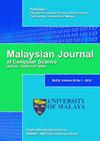基于最长公共子序列的句子相似度特征工程用于电子邮件分类
IF 1.2
4区 计算机科学
Q4 COMPUTER SCIENCE, ARTIFICIAL INTELLIGENCE
引用次数: 1
摘要
特征选择在电子邮件分类中起着重要的作用,因为选择最相关的特征可以提高学习分类器的准确性和性能。由于电子邮件的使用呈指数级增长,这类电子邮件的分类出现了一个拟合问题。因此,需要一个适当的分类系统。这样的电子邮件分类系统需要一种高效的特征选择方法来准确分类最相关的特征。提出了一种基于最长公共子序列的句子相似度特征选择方法。所提出的特征选择方法主要分为两个阶段:首先,通过将每个电子邮件与数据集中的所有其他电子邮件进行比较,构建特征的最长公共子序列向量;然后,使用与特定类的电子邮件最接近的特征为每个类构造一个模板。此外,使用这些模板对未见过的电子邮件进行电子邮件分类测试。并与传统的特征选择方法如TF-IDF、信息增益、卡方和语义方法进行了性能比较。实验结果表明,该方法的准确率为96.61%。本文章由计算机程序翻译,如有差异,请以英文原文为准。
FEATURE ENGINEERING WITH SENTENCE SIMILARITY USING THE LONGEST COMMON SUBSEQUENCE FOR EMAIL CLASSIFICATION
Feature selection plays a prominent role in email classification since selecting the most relevant features enhances the accuracy and performance of the learning classifier. Due to the exponential increase rate in the usage of emails, the classification of such emails posed a fitting problem. Therefore, there is a requirement for a proper classification system. Such an email classification system requires an efficient feature selection method for the accurate classification of the most relevant features. This paper proposes a novel feature selection method for sentence similarity using the longest common subsequence for email classification. The proposed feature selection method works in two main phases: First, it builds the longest common subsequence vector of features by comparing each email with all other emails in the dataset. Later, a template is constructed for each class using the closest features of emails of a particular class. Further, email classification is tested for unseen emails using these templates. The performance of the proposed method is compared with traditional feature selection methods such as TF-IDF, Information Gain, Chi-square, and semantic approach. The experimental results showed that the proposed method performed well with 96.61% accuracy.
求助全文
通过发布文献求助,成功后即可免费获取论文全文。
去求助
来源期刊

Malaysian Journal of Computer Science
COMPUTER SCIENCE, ARTIFICIAL INTELLIGENCE-COMPUTER SCIENCE, THEORY & METHODS
CiteScore
2.20
自引率
33.30%
发文量
35
审稿时长
7.5 months
期刊介绍:
The Malaysian Journal of Computer Science (ISSN 0127-9084) is published four times a year in January, April, July and October by the Faculty of Computer Science and Information Technology, University of Malaya, since 1985. Over the years, the journal has gained popularity and the number of paper submissions has increased steadily. The rigorous reviews from the referees have helped in ensuring that the high standard of the journal is maintained. The objectives are to promote exchange of information and knowledge in research work, new inventions/developments of Computer Science and on the use of Information Technology towards the structuring of an information-rich society and to assist the academic staff from local and foreign universities, business and industrial sectors, government departments and academic institutions on publishing research results and studies in Computer Science and Information Technology through a scholarly publication. The journal is being indexed and abstracted by Clarivate Analytics'' Web of Science and Elsevier''s Scopus
 求助内容:
求助内容: 应助结果提醒方式:
应助结果提醒方式:


